
What do the numbers mean? A survey is administered by a marketing firm. Two of the people surveyed are Brenda and Jason. Three of the questions are as follows:
- Do you favor the construction of a new shopping mall?
- How many cars do you own?
- What is your marital slams?
(1) Strongly oppose (2) Somewhat oppose (3) Neutral (4) Somewhat favor (5) Strongly favor
(1) Married (2) Single (3) Divorced (4) Domestically partnered (5) Other
- Are the responses for question (i) nominal or ordinal?
- On question (i), Brenda answers (2) and Jason answers (4). Jason’s answer (4) is greater than Brenda’s answer (2). Does Jason’s answer reflect more of something?
- Jason’s answer to question (i) is twice as large as Brenda’s answer. Does Jason’s answer reflect twice as much of something? Explain.
- Are the responses for question (ii) qualitative or quantitative?
- On question (ii). Brenda answers 2 and Jason answers 1. Does Brenda’s answer reflect more of something? Does Brenda’s answer reflect twice as much of something? Explain.
- Are the responses for question (iii) nominal or ordinal?
- On question (iii). Brenda answers (4) and Jason answers (2). Does Brenda’s answer reflect more of something? Does Brenda’s answer reflect twice as much of something? Explain.
a.
To identify:whether the responses for question (i) nominal or ordinal.
Answer to Problem 49E
The responses for question (i): ordinal.
Explanation of Solution
Given information:A survey is administered by a marketing firm. Two of the people surveyed are Brenda and Jason. Three of the questions are as follows:
Do you favor the construction of a new shopping mall?
(1) Strongly oppose (2) Somewhat oppose (3) Neutral (4) Somewhat favor (5) Strongly favor
ii. How many cars do you own?
iii. What is your marital status?
(1) Married (2) Single (3) Divorced (4) Domestically partnered (5) Other
Concept Involved:
There are various methods of collecting information by sampling. Once the information has been collected, the collection is called a data set. Variables can be divided into two types: qualitative and quantitative. Qualitative variables are also called categorical variable, classify individuals into categories. Quantitative variables are numerical and tell how much of something there is.
Qualitative variables come in two types: ordinal variables and nominal variables.
Ordinal variables are qualitative variables whose categories have a natural ordering.
Nominal variables are qualitative variables whose categories have no natural ordering.
Quantitative variables can be either discrete or continuous.
Discrete variables are those whose possible values can be listed. Often, discrete variables result from counting something, so the possible values of the variable are 0, 1, 2 and so forth.
Continuous variables can, in principle, take on any value within some interval.
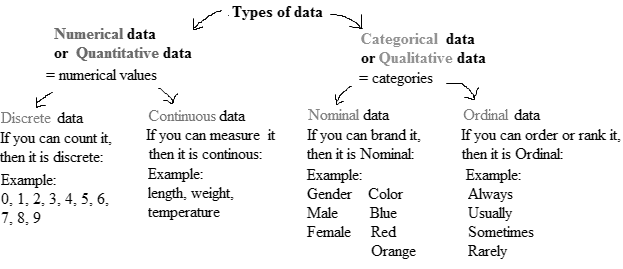
The values are classified into categories in a nominal variable, but no natural ordering is there in categories, whereas, the values are also classified into categories in an ordinary variablebut a natural ordering is there in categories.
Thus, to given question the choices for response has natural ordering with strongly oppose which indicating negative opinion and favor stating intensely positive feedback is ordinal variable.
Therefore, responses to given question are ordinal.
b.
To identify:Whether Jason’s answer reflects more of something.
Answer to Problem 49E
Jason’s answer reflects that he is favor of constructing a new shopping mall unlike Brenda
Explanation of Solution
Given information: A survey is administered by a marketing firm. Two of the people surveyed are Brenda and Jason. Three of the questions are as follows:
i. Do you favor the construction of a new shopping mall?
(1) Strongly oppose (2) Somewhat oppose (3) Neutral (4) Somewhat favor (5) Strongly favor
ii. How many cars do you own?
iii. What is your marital status?
(1) Married (2) Single (3) Divorced (4) Domestically partnered (5) Other
On question (i), Brenda answers (2) and Jason answers (4). Jason’s answer (4) is greater than Brenda’s answer (2).
Concept Involved:
There are various methods of collecting information by sampling. Once the information has been collected, the collection is called a data set. Variables can be divided into two types: qualitative and quantitative. Qualitative variables are also called categorical variable, classify individuals into categories. Quantitative variables are numerical and tell how much of something there is.
Qualitative variables come in two types: ordinal variables and nominal variables.
Ordinal variables are qualitative variables whose categories have a natural ordering.
Nominal variables are qualitative variables whose categories have no natural ordering.
Quantitative variables can be either discrete or continuous.
Discrete variables are those whose possible values can be listed. Often, discrete variables result from counting something, so the possible values of the variable are 0, 1, 2 and so forth.
Continuous variables can, in principle, take on any value within some interval.
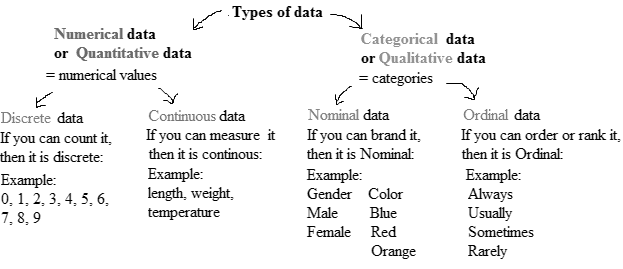
It is given that Brenda answered 2 and Jason answered 4. Thus Jason’s answer reflect more of positivity, as he though not sure of intensity of favoring the construction supported it, unlike Brenda.
c.
To identify:Whether Jason’s answer reflects twice as much of something.
Answer to Problem 49E
The variable response to given question is categorical in nature, so it doesn’t not imply Jason’s answer to given question is twice as much of something
Explanation of Solution
Given information: A survey is administered by a marketing firm. Two of the people surveyed are Brenda and Jason. Three of the questions are as follows:
i. Do you favor the construction of a new shopping mall?
(1) Strongly oppose (2) Somewhat oppose (3) Neutral (4) Somewhat favor (5) Strongly favor
ii. How many cars do you own?
iii. What is your marital status?
(1) Married (2) Single (3) Divorced (4) Domestically partnered (5) Other
Jason’s answer to question (i) is twice as large as Brenda’s answer.
Concept Involved:
There are various methods of collecting information by sampling. Once the information has been collected, the collection is called a data set. Variables can be divided into two types: qualitative and quantitative. Qualitative variables are also called categorical variable, classify individuals into categories. Quantitative variables are numerical and tell how much of something there is.
Qualitative variables come in two types: ordinal variables and nominal variables.
Ordinal variables are qualitative variables whose categories have a natural ordering.
Nominal variables are qualitative variables whose categories have no natural ordering.
Quantitative variables can be either discrete or continuous.
Discrete variables are those whose possible values can be listed. Often, discrete variables result from counting something, so the possible values of the variable are 0, 1, 2 and so forth.
Continuous variables can, in principle, take on any value within some interval.
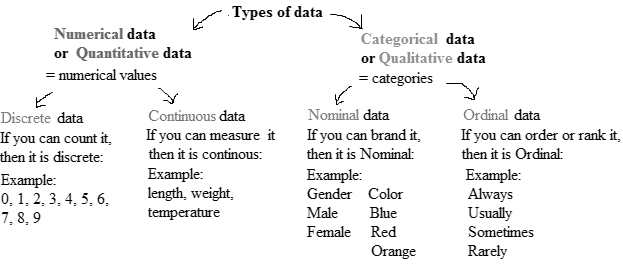
It is given that Brenda answered 2 and Jason answered 4. Thus Jason’s answer reflect more of positivity, as he though not sure of intensity of favoring the construction supported it, unlike Brenda. It is given Jason’s answer to given question is twice as large as Brenda, which does not implies twice as much of something, because, the variable response to given question is categorical in nature.
d.
To identify:Whether question (ii) qualitative or quantitative.
Answer to Problem 49E
The responses for question (ii): quantitative
Explanation of Solution
Given information: A survey is administered by a marketing firm. Two of the people surveyed are Brenda and Jason. Three of the questions are as follows:
i. Do you favor the construction of a new shopping mall?
(1) Strongly oppose (2) Somewhat oppose (3) Neutral (4) Somewhat favor (5) Strongly favor
ii. How many cars do you own?
iii. What is your marital status?
(1) Married (2) Single (3) Divorced (4) Domestically partnered (5) Other
Concept Involved:
There are various methods of collecting information by sampling. Once the information has been collected, the collection is called a data set. Variables can be divided into two types: qualitative and quantitative. Qualitative variables are also called categorical variable, classify individuals into categories. Quantitative variables are numerical and tell how much of something there is.
Qualitative variables come in two types: ordinal variables and nominal variables.
Ordinal variables are qualitative variables whose categories have a natural ordering.
Nominal variables are qualitative variables whose categories have no natural ordering.
Quantitative variables can be either discrete or continuous.
Discrete variables are those whose possible values can be listed. Often, discrete variables result from counting something, so the possible values of the variable are 0, 1, 2 and so forth.
Continuous variables can, in principle, take on any value within some interval.
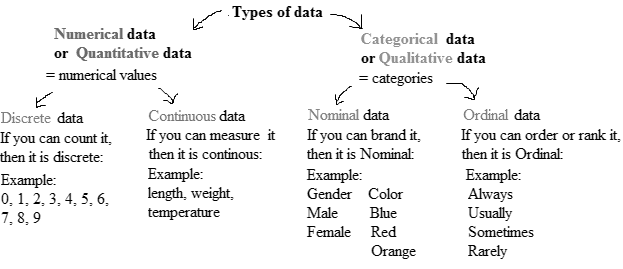
The variable which classifies individuals into categories is called qualitative variable, and the variable whichprovide information aboutquantity or number of something is quantitative variable. The variable number of cars owned by one tells how many cars one had been capable of possessing.
Therefore, the response is quantitative in nature.
e.
To identify:Whether Brenda’s answer reflect more of something and does it reflect Brenda’s answer is twice as much as something.
Answer to Problem 49E
The response is quantitative, Brenda’s answer reflect that she have more cars than Jason.
Yes! Brenda’s answer reflect that she have twice as many cars as what Jason have.
Explanation of Solution
Given information: A survey is administered by a marketing firm. Two of the people surveyed are Brenda and Jason. Three of the questions are as follows:
i. Do you favor the construction of a new shopping mall?
(1) Strongly oppose (2) Somewhat oppose (3) Neutral (4) Somewhat favor (5) Strongly favor
ii. How many cars do you own?
iii. What is your marital status?
(1) Married (2) Single (3) Divorced (4) Domestically partnered (5) Other
On question (ii), Brenda answers 2 and Jason answers 1.
Concept Involved:
There are various methods of collecting information by sampling. Once the information has been collected, the collection is called a data set. Variables can be divided into two types: qualitative and quantitative. Qualitative variables are also called categorical variable, classify individuals into categories. Quantitative variables are numerical and tell how much of something there is.
Qualitative variables come in two types: ordinal variables and nominal variables.
Ordinal variables are qualitative variables whose categories have a natural ordering.
Nominal variables are qualitative variables whose categories have no natural ordering.
Quantitative variables can be either discrete or continuous.
Discrete variables are those whose possible values can be listed. Often, discrete variables result from counting something, so the possible values of the variable are 0, 1, 2 and so forth.
Continuous variables can, in principle, take on any value within some interval.
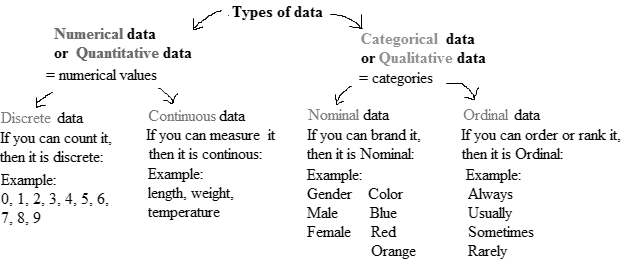
It is given that Brenda answered 2 and Jason answered 1 in response to given question, which clearly implies Brenda owns more cars than Jason. Brenda’s answer reflects twice as much as cars than Jason.
f.
To identify:Whether the responses to question (iii) nominal or ordinal.
Answer to Problem 49E
The responses to question (iii): nominal.
Explanation of Solution
Given information: A survey is administered by a marketing firm. Two of the people surveyed are Brenda and Jason. Three of the questions are as follows:
i. Do you favor the construction of a new shopping mall?
(1) Strongly oppose (2) Somewhat oppose (3) Neutral (4) Somewhat favor (5) Strongly favor
ii. How many cars do you own?
iii. What is your marital status?
(1) Married (2) Single (3) Divorced (4) Domestically partnered (5) Other
Concept Involved:
There are various methods of collecting information by sampling. Once the information has been collected, the collection is called a data set. Variables can be divided into two types: qualitative and quantitative. Qualitative variables are also called categorical variable, classify individuals into categories. Quantitative variables are numerical and tell how much of something there is.
Qualitative variables come in two types: ordinal variables and nominal variables.
Ordinal variables are qualitative variables whose categories have a natural ordering.
Nominal variables are qualitative variables whose categories have no natural ordering.
Quantitative variables can be either discrete or continuous.
Discrete variables are those whose possible values can be listed. Often, discrete variables result from counting something, so the possible values of the variable are 0, 1, 2 and so forth.
Continuous variables can, in principle, take on any value within some interval.
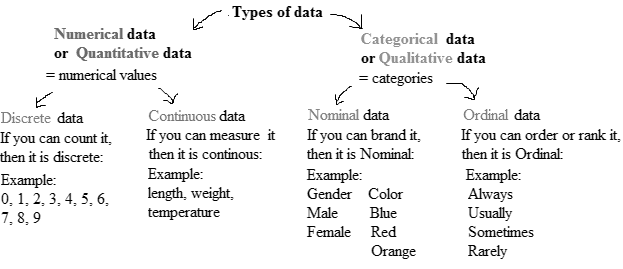
The values are classified into categories in a nominal variable, but no natural ordering is there in categories, whereas, the values are also classified into categories in an ordinary variable but a natural ordering is there in categories.
Thus, the responses to given question classifies one’s marital status into five categories.
Therefore, responses to given question are nominal.
g.
To identify:Whether Brenda’s answers reflect more of something and reflect twice as much as something.
Answer to Problem 49E
Brenda’s response of 4 and Jason’s response of 2 do not reflect more of something. Brenda’s answer does not reflect twice as much as Jason’s.
Explanation of Solution
Given information: A survey is administered by a marketing firm. Two of the people surveyed are Brenda and Jason. Three of the questions are as follows:
i. Do you favor the construction of a new shopping mall?
(1) Strongly oppose (2) Somewhat oppose (3) Neutral (4) Somewhat favor (5) Strongly favor
ii. How many cars do you own?
iii. What is your marital status?
- Married (2) Single (3) Divorced (4) Domestically partnered (5) Other On question (iii), Brenda answers (4) and Jason answers (2).
Concept Involved:
There are various methods of collecting information by sampling. Once the information has been collected, the collection is called a data set. Variables can be divided into two types: qualitative and quantitative. Qualitative variables are also called categorical variable, classify individuals into categories. Quantitative variables are numerical and tell how much of something there is.
Qualitative variables come in two types: ordinal variables and nominal variables.
Ordinal variables are qualitative variables whose categories have a natural ordering.
Nominal variables are qualitative variables whose categories have no natural ordering.
Quantitative variables can be either discrete or continuous.
Discrete variables are those whose possible values can be listed. Often, discrete variables result from counting something, so the possible values of the variable are 0, 1, 2 and so forth.
Continuous variables can, in principle, take on any value within some interval.
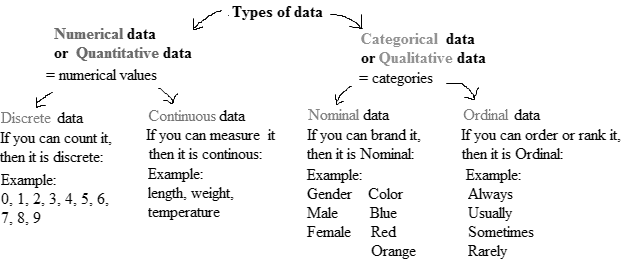
The values are classified into categories in a nominal variable, but no natural ordering is there in categories, whereas, the values are also classified into categories in an ordinary variable but a natural ordering is there in categories.
Thus, the responses to given question classifies one’s marital status into five categories.
Response to Marital status are nominal in nature, thus primarily the variable marital status is categorical. Hence, Brenda’s response of 4 and Jason’s response of 2 do not reflect more of something.
Therefore, Brenda’s answer does not reflect twice as much as Jason’s
Want to see more full solutions like this?
Chapter 1 Solutions
Connect Hosted by ALEKS Online Access for Elementary Statistics
- What do you guess are the standard deviations of the two distributions in the previous example problem?arrow_forwardPlease answer the questionsarrow_forward30. An individual who has automobile insurance from a certain company is randomly selected. Let Y be the num- ber of moving violations for which the individual was cited during the last 3 years. The pmf of Y isy | 1 2 4 8 16p(y) | .05 .10 .35 .40 .10 a.Compute E(Y).b. Suppose an individual with Y violations incurs a surcharge of $100Y^2. Calculate the expected amount of the surcharge.arrow_forward
- 24. An insurance company offers its policyholders a num- ber of different premium payment options. For a ran- domly selected policyholder, let X = the number of months between successive payments. The cdf of X is as follows: F(x)=0.00 : x < 10.30 : 1≤x<30.40 : 3≤ x < 40.45 : 4≤ x <60.60 : 6≤ x < 121.00 : 12≤ x a. What is the pmf of X?b. Using just the cdf, compute P(3≤ X ≤6) and P(4≤ X).arrow_forward59. At a certain gas station, 40% of the customers use regular gas (A1), 35% use plus gas (A2), and 25% use premium (A3). Of those customers using regular gas, only 30% fill their tanks (event B). Of those customers using plus, 60% fill their tanks, whereas of those using premium, 50% fill their tanks.a. What is the probability that the next customer will request plus gas and fill the tank (A2 B)?b. What is the probability that the next customer fills the tank?c. If the next customer fills the tank, what is the probability that regular gas is requested? Plus? Premium?arrow_forward38. Possible values of X, the number of components in a system submitted for repair that must be replaced, are 1, 2, 3, and 4 with corresponding probabilities .15, .35, .35, and .15, respectively. a. Calculate E(X) and then E(5 - X).b. Would the repair facility be better off charging a flat fee of $75 or else the amount $[150/(5 - X)]? [Note: It is not generally true that E(c/Y) = c/E(Y).]arrow_forward
- 74. The proportions of blood phenotypes in the U.S. popula- tion are as follows:A B AB O .40 .11 .04 .45 Assuming that the phenotypes of two randomly selected individuals are independent of one another, what is the probability that both phenotypes are O? What is the probability that the phenotypes of two randomly selected individuals match?arrow_forward53. A certain shop repairs both audio and video compo- nents. Let A denote the event that the next component brought in for repair is an audio component, and let B be the event that the next component is a compact disc player (so the event B is contained in A). Suppose that P(A) = .6 and P(B) = .05. What is P(BA)?arrow_forward26. A certain system can experience three different types of defects. Let A;(i = 1,2,3) denote the event that the sys- tem has a defect of type i. Suppose thatP(A1) = .12 P(A) = .07 P(A) = .05P(A, U A2) = .13P(A, U A3) = .14P(A2 U A3) = .10P(A, A2 A3) = .011Rshelfa. What is the probability that the system does not havea type 1 defect?b. What is the probability that the system has both type 1 and type 2 defects?c. What is the probability that the system has both type 1 and type 2 defects but not a type 3 defect? d. What is the probability that the system has at most two of these defects?arrow_forward
- The following are suggested designs for group sequential studies. Using PROCSEQDESIGN, provide the following for the design O’Brien Fleming and Pocock.• The critical boundary values for each analysis of the data• The expected sample sizes at each interim analysisAssume the standardized Z score method for calculating boundaries.Investigators are evaluating the success rate of a novel drug for treating a certain type ofbacterial wound infection. Since no existing treatment exists, they have planned a one-armstudy. They wish to test whether the success rate of the drug is better than 50%, whichthey have defined as the null success rate. Preliminary testing has estimated the successrate of the drug at 55%. The investigators are eager to get the drug into production andwould like to plan for 9 interim analyses (10 analyzes in total) of the data. Assume thesignificance level is 5% and power is 90%.Besides, draw a combined boundary plot (OBF, POC, and HP)arrow_forwardPlease provide the solution for the attached image in detailed.arrow_forward20 km, because GISS Worksheet 10 Jesse runs a small business selling and delivering mealie meal to the spaza shops. He charges a fixed rate of R80, 00 for delivery and then R15, 50 for each packet of mealle meal he delivers. The table below helps him to calculate what to charge his customers. 10 20 30 40 50 Packets of mealie meal (m) Total costs in Rands 80 235 390 545 700 855 (c) 10.1. Define the following terms: 10.1.1. Independent Variables 10.1.2. Dependent Variables 10.2. 10.3. 10.4. 10.5. Determine the independent and dependent variables. Are the variables in this scenario discrete or continuous values? Explain What shape do you expect the graph to be? Why? Draw a graph on the graph provided to represent the information in the table above. TOTAL COST OF PACKETS OF MEALIE MEAL 900 800 700 600 COST (R) 500 400 300 200 100 0 10 20 30 40 60 NUMBER OF PACKETS OF MEALIE MEALarrow_forward
 Big Ideas Math A Bridge To Success Algebra 1: Stu...AlgebraISBN:9781680331141Author:HOUGHTON MIFFLIN HARCOURTPublisher:Houghton Mifflin Harcourt
Big Ideas Math A Bridge To Success Algebra 1: Stu...AlgebraISBN:9781680331141Author:HOUGHTON MIFFLIN HARCOURTPublisher:Houghton Mifflin Harcourt Holt Mcdougal Larson Pre-algebra: Student Edition...AlgebraISBN:9780547587776Author:HOLT MCDOUGALPublisher:HOLT MCDOUGAL
Holt Mcdougal Larson Pre-algebra: Student Edition...AlgebraISBN:9780547587776Author:HOLT MCDOUGALPublisher:HOLT MCDOUGAL Glencoe Algebra 1, Student Edition, 9780079039897...AlgebraISBN:9780079039897Author:CarterPublisher:McGraw Hill
Glencoe Algebra 1, Student Edition, 9780079039897...AlgebraISBN:9780079039897Author:CarterPublisher:McGraw Hill Functions and Change: A Modeling Approach to Coll...AlgebraISBN:9781337111348Author:Bruce Crauder, Benny Evans, Alan NoellPublisher:Cengage Learning
Functions and Change: A Modeling Approach to Coll...AlgebraISBN:9781337111348Author:Bruce Crauder, Benny Evans, Alan NoellPublisher:Cengage Learning Algebra and Trigonometry (MindTap Course List)AlgebraISBN:9781305071742Author:James Stewart, Lothar Redlin, Saleem WatsonPublisher:Cengage Learning
Algebra and Trigonometry (MindTap Course List)AlgebraISBN:9781305071742Author:James Stewart, Lothar Redlin, Saleem WatsonPublisher:Cengage Learning Algebra: Structure And Method, Book 1AlgebraISBN:9780395977224Author:Richard G. Brown, Mary P. Dolciani, Robert H. Sorgenfrey, William L. ColePublisher:McDougal Littell
Algebra: Structure And Method, Book 1AlgebraISBN:9780395977224Author:Richard G. Brown, Mary P. Dolciani, Robert H. Sorgenfrey, William L. ColePublisher:McDougal Littell





